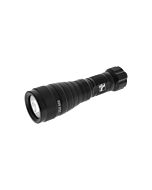TekTite Expedition Star Backup Light (Alkaline)
- High-power LED with 240 Lumens in ultra-tight 6° beam pattern
- 15+ hours burn time on three included C-cell alkaline batteries
- Depth rated to {500 ft | 150 m } with reliable twist-on activation
- Non-slip grip body is { 8 in | 20 cm } long x { 2 in | 5 cm} diameter
- Impact resistant ABS body and clear LEXAN® lens material with rubber lens guard
TekTite Expedition Star Backup Light (Alkaline)
The TekTite Expedition Star offers high-power LED with 240 Lumens light output in an ultra-tight 6-degree beam pattern for technical diving applications, double O-ring sealed IP68M depth rated to {500 ft | 150 m } and twist-on activation. Impact resistant ABS non-slip grip body and LEXAN® lens material with rubber lens guard includes sturdy attachment point for snap. Powered by ordinary three C-cell alkaline batteries (non-rechargeable), burn time is 15+ hours at full power with up to 50 hours of usable light as the battery power declines. This light meets the GUE training requirement that backup lights should be powered by alkaline batteries. European Union CE rating compliant and military issue tough as used by US/NATO forces, the TekTite Expedition Star also includes a limited LIFETIME Warranty from TekTite.
| Brand | TekTite |
|---|---|
| SKU | TTI-3C-9500-4 |
| Weight | 1.000000 |
Customer Reviews
 WARNING
WARNING
Do not store any handheld flashlight or strobe for extended periods with alkaline batteries remaining inside the device, because unused alkaline chemistry batteries are prone to leaking. When alkaline chemistry batteries remain in unused devices for long periods, hydrogen gas can build up inside the cell casing until the pressure causes it to rupture, allowing the chemical components to leak out.
YOU MAY ALSO BE INTERESTED IN THE FOLLOWING PRODUCT(S)
How to use a twist-on handheld dive light or strobe
Before diving with a new twist on handheld, learn how to properly operate your light or strobe so you don't flood it. While it might appear obvious how to turn the light or strobe on, getting confused or uncertain about what direction to twist is the most common reason for floods.
- Properly insert the batteries in to the body or in some cases in to a carrier that is then inserted in to the body. Pay attention to the markings. Most batteries load with the positive end pointing toward the light head but a few designs load with the positive end pointing away from the light head. If there is more than one battery and especially if there is a carrier, double check to make sure all batteries are oriented correctly - many carrier designs have one battery that is oriented opposite from all the others. Most lights ship with a small adhesive plastic cover on the end to prevent activation during shipping, if so remove and discard. Failing to properly load batteries is the most common explanation for seemingly "dead-on-arrival" lights.
- Hold the light head steady in one hand, then use the other hand to turn the body so that it screws in toward the head to activate. For most designs the motion of twisting the body will be clockwise, but a few designs are counter clockwise. Continue twisting the light body until the body just stops against the head and the light is on. Tighter is not better; it is the O-ring that makes the seal. Particularly for lights or strobes with a plastic body or head, over-tightening the two parts together can warp the sealing surfaces and cause a flood.
- Turn the light off by reversing the direction of the activation motion at least one-half revolution and typically NO MORE THAN ONE FULL REVOLUTION. However, make at least one-half revolution past where the light does go off because just backing off slightly can cause the light to turn back on by itself when descending. Dry practice turning the light on and off several times by holding the light head steady in one hand while turning ONLY the body in the other hand. It's also a good idea to switch the hands holding the head and body to become familiar with these motions regardless of how the light is being held.
- Each time before entering the water with the light, practice once more as a reminder of the twist motion and to verify the light is working. Make it a habit to do this while looking closely at the twist motion. Skipping this check is how floods often happen: the light hasn't been checked and the batteries are dead or inserted incorrectly. Once underwater, if the light does not come on when twisting it no more than one full revolution, then STOP twisting. If you are turning the wrong direction then continuing to twist will take only one or two more revolutions before breaking the O-ring seal and causing a flood.
- Do not store any handheld light or strobe for extended periods with batteries remaining inside the device. This is especially true for alkaline chemistry batteries that can leak. If your dive light uses rechargeable batteries, then please read Care and Feeding of Lithium Chemistry Rechargeable Batteries.









